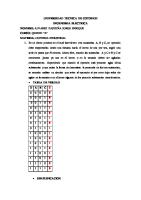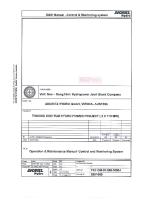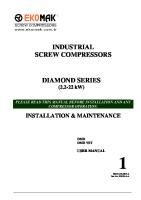Scania DEC2 Control System: Industrial & Marine Engines [PDF]
03:02-02 Issue 1 Industrial & Marine Engines Scania DEC2 control system Work description Diagnostics and fault finding
33 1 138KB
Papiere empfehlen
![Scania DEC2 Control System: Industrial & Marine Engines [PDF]](https://vdoc.tips/img/200x200/scania-dec2-control-system-industrial-amp-marine-engines.jpg)
- Author / Uploaded
- Gleison Gomes
Datei wird geladen, bitte warten...
Zitiervorschau
03:02-02 Issue 1 Industrial & Marine Engines
Scania DEC2 control system Work description Diagnostics and fault finding
Part. No. 1 588 593
©
Scania CV AB, Sweden, 1999-01:1
en
Important information
• Changes must not be made to the DEC2 control unit or sensors and wiring. Doing so may effect the control unit’s safety system and cause damage to the operator, the engine or driven equipment. • The sensors for the DEC2 control system are dedicated for use in DEC2 only. • Check that the cables for the battery and alternator/s are properly connected before starting the engine as otherwise the DEC2 control unit might be damaged. • Before disconnecting the cable to the control unit, all power to the unit should first be switched off. If not, the DEC2 control unit may be damaged. • Disconnect the DEC2 control unit when boost charging the battery to avoid damaging the control unit. • Never splice a damaged cable. Change the entire cable, otherwise the safety and operation of the system could be impaired. • Disconnect the battery if arc welding in order to avoid damage to the DEC2 control unit.
Contents Engine protection . . . . . . . . . . . . . . . . . . . . . . . . . . . . . . . . . . . . . . . . . . .3 Diagnostics. . . . . . . . . . . . . . . . . . . . . . . . . . . . . . . . . . . . . . . . . . . . . . . .3 Fault finding. . . . . . . . . . . . . . . . . . . . . . . . . . . . . . . . . . . . . . . . . . . . . . .4 Main indicator lamp (operator’s lamp) . . . . . . . . . . . . . . . . . . . . . . . . .4 Lamp test/fault code switch . . . . . . . . . . . . . . . . . . . . . . . . . . . . . . . . .4 Fault finding procedure . . . . . . . . . . . . . . . . . . . . . . . . . . . . . . . . . . . . . .5 LED indications at operation if a fault arises. . . . . . . . . . . . . . . . . . . .5 Critical faults that cause shutdown . . . . . . . . . . . . . . . . . . . . . . . . . . . .6 Necessary actions on POWER - . . . . . . . . . . . . . . . . . . . . . . . . . . . . . .6 Necessary actions on SHUTDOWN . . . . . . . . . . . . . . . . . . . . . . . . . . .7 Failure of input signal to speed throttle/trim interface . . . . . . . . . . . . .7 Setting functions with DIP switches in control unit . . . . . . . . . . . . . . .8 Obtaining readouts of fault codes . . . . . . . . . . . . . . . . . . . . . . . . . . . . .9
2
©
Scania CV AB, Sweden, 1999-01:1
03:02-02
Engine protection
Diagnostics
The control unit contains monitoring functions to protect the engine in the event of a fault which would otherwise damage it. If such a fault condition is detected, the control unit will take steps to alter the control program to ensure acceptable power output and to reduce the possibility of damage to the engine. If this is not possible, the system will for some faults provide only enough power to move a vehicle or vessel to a location where service assistance can be obtained. Only when there is a risk of excessive damage to the engine or the engine cannot be safely controlled, the engine will be switched off automatically. The most important fault conditions that the control unit provides protection against are: • overspeed • low oil pressure • high coolant temperature • high air inlet temperature.
Diagnostics capabilities are integrated with the control unit and allows the system to detect and adjust for a variety of faults. Through a diagnosticts port, authorized service personnel are able to connect a computer (PC) to investigate the cause of most problems. The control unit contains a fault memory which retains important information regarding detected faults. Note The COMM/DIAG port is for use by authorized personnel only.
The control unit is also constantly monitoring itself to detect faults in its own operation. All these features work together to allow maximum power output and at the same time reduce the possibility of engine damage.
03:02-02
©
Scania CV AB, Sweden, 1999-01:1
3
Fault finding Even though the control provides sophisticated fault detection and correction, this does not make it too complex for the operator to determine minor problems without test equipment and to take appropriate measures. Any fault that is field correctable will be displayed on the LED display on the control unit when performing a fault finding procedure. In order to read fault indications on the LEDs, a lamp test/fault code switch must be mounted close to the control unit so that the LEDs can be viewed when the switch is activated. Main indicator lamp (operator’s lamp)
Lamp test/fault code switch This switch should be installed close to the DEC2 control unit. The recommended type of switch is a spring return switch with - (minus) in the rest position. Before reading off the fault on the LEDs on the control panel, this switch must be depressed. The lamp test function will then turn on all LEDs for a short moment and then the LED fault code will be displayed. See page 9 for the complete fault code reading procedure.
If a fault arises, the main indicator lamp installed at the operator’s panel will come on. - If the main indicator lamp comes on with a constant red light, the DEC2 control unit has detected a fault, indicating that a warning threshold has been reached (POWER- status). - If the main indicator lamp comes on with a flashing red light, the DEC2 control unit has detected a fault, indicating that a shutdown threshold has been reached. Engine is stopped if DIP switch 4 is in OFF position.
4
©
Scania CV AB, Sweden, 1999-01:1
03:02-02
Fault finding procedure LED indications at operation if a fault arises Note Indication is given by the main indicator lamp on the operator instrument panel. The lamp test/fault code switch should not be depressed. CONTROL STATUS
✹
The LED continues to flash even if a fault has arisen and this indicates that the control unit is functioning normally. POWER -
✹
If the LED comes on, the control unit has detected a fault condition which could result in engine damage if allowed to continue. The control unit automatically reduces engine power output to a certain level. See page 6 for appropriate action. SHUTDOWN
✹
The LED comes on and the engine is switched off automatically if a fault of such seriousness has arisen that the engine could be damaged if it continues to run. See page 6 for a listing of critical faults. See page 7 for appropriate action.
03:02-02
©
Scania CV AB, Sweden, 1999-01:1
5
Critical faults that cause shutdown • Coolant temperature exceeds shutdown threshold and DIP switch 4 is in OFF position. • Oil pressure is below shutdown threshold and DIP switch 4 is in OFF position. • Accelerator sensor failure and DIP switch 5 is in OFF position. All speed unit only. • Actuator feed-back sensor failure. • Actuator feedback sensor non-volatile calibration data failure. • Engine speed exceeds overspeed threshold. • Torque map non-volatile data failure. • Internal self-test failures.
Necessary actions on POWER The main indicator lamp is shining constantly red and the control unit has reduced engine power output to a certain level. Note Do not switch off the control unit’s power supply. The fault codes will be reset to zero if the system’s power supply is turned off. - If possible, adjust engine rpm to low idle and check the oil pressure and coolant temperature gauges on the operator instrument panel. - Low oil pressure always entails a danger of engine damage. The engine should be used only in an emergency and for as short time as possible, keeping a sharp eye on the instrument. - If the oil pressure continues to drop, the engine must be stopped. If DIP switch 4 is set in the OFF position, the engine will be stopped automatically. - If the coolant temperature is abnormally high, 98 °C or above, the engine should be stopped as soon as possible and the cooling system inspected. - If you have to keep the engine running, reduce its output power still further and check the temperature gauge constantly. If the temperature continues to rise, the engine will be stopped automatically (shutdown) if DIP switch 4 is in the OFF position. - Obtain a reading of the fault codes as described on page 9. You should not switch off the engine to do this in the case of Power- .
6
©
Scania CV AB, Sweden, 1999-01:1
03:02-02
Necessary actions on SHUTDOWN The main indicator lamp shines with a flashing red light. Note Do not switch off the control unit’s power supply. The fault codes will be reset to zero if the system’s power supply is turned off. - Obtain a reading of fault codes on the control unit as described on page 9. - The Shutdown function for too low oil pressure and too high coolant temperature can be disconnected by setting DIP switch No. 4 in the ON position. The system will then automatically go into Power- (LOP-power). See page 8. This possibility should be utilized only in exceptional circumstances when it is absolutely necessary to move a vehicle or a boat. - If Shutdown has occurred due to overrevving, the control unit must be switched off before the engine is started again.
Failure of input signal to speed throttle/trim interface
- Single speed units with trim pot: If the excitation (TPSE) or sensor (TPSS) signal is discontinued, the control unit will use full negative trim (approx. -90 rpm) if the trim input is enabled with the Speed Hold switch in Battery- position. If the return (TPSR) is discontinued, the control unit will use full positive trim (approx. +90 rpm) if the trim input is enabled with the Speed Hold switch in Battery- position.
Cable or connection failure to discrete inputs If there is a breakage to any of the discrete inputs in the control unit or if it is not connected, there will be an automatic internal pulldown to battery-. This will result in the following function mode for each of the dicretes (switches): Droop/Isochronous: Droop mode Power Control:
Torque Map 1
Run/Stop:
Turns off actuator driver
Speed Hold:
No speed hold
Lamp Test/Fault code:Running mode Idle/Run:
Idle speed
- All speed units with APS (accelerator pedal sensor): If the excitation (TPSE) or sensor (TPSS) signal is discontinued, this failure of the sensor will result in the following: The engine first slows down to idle and then increases to a fixed speed of 900 rpm + droop or shutdown depending on the position of DIP switch 5. If the return (TPSR) is discontinued, the engine will first accelerate towards full speed and then this sensor failure will result in the same operating mode as above.
03:02-02
©
Scania CV AB, Sweden, 1999-01:1
7
Setting functions with DIP switches in control unit There are 8 DIP switches in the control unit under the black, round rubber cover.
No
The switches have the following functions in the on or off positions.
ON
OFF
1
Standard position
2
Standard position
3
Standard position
4
LOP(Power-) with shutdown values for low Shutdown position for low oil pressure and oil pressure and/or high coolant temperature high coolant temperature
5
Fixed speed operation for failed throttle input signal (900 rpm + droop)
6
All speed: Standard position Single speed: Low speed request (1500 rpm) Single speed: High speed request (1800 rpm)
7
Unloaded droop calculation
Loaded droop calculation
8
Droop for Map 2 operation
Droop for Map1 operation
Calibration position (injection pump-DEC2)
Shutdown for failed throttle input signal
- As described earlier, DIP switch 4 can be set in the ON position to disconnect the Shutdown function for low oil pressure and high coolant temperature. The engine can then be run even if the indicated oil pressure is so low or the indicated coolant temperature so high that Shutdown would normally occur. The Power- (LOP power) operating mode is engaged automatically.
DIP switches shown in ON position
8
©
Scania CV AB, Sweden, 1999-01:1
03:02-02
Obtaining readouts of fault codes
Note If the engine has stopped or lost power but the operator’s lamp is out and neither POWER- nor SHUTDOWN are on, the fault is outside the control unit’s sensing area. Probable causes: fuel shortage, temporary overload, mechanical fault.
- After having made a note of the fault code shown, reset the lamp test/fault code switch and the control unit by turning off its power supply momentarily. - The most probable cause of the fault can then be found in the trouble shooting schedule on the next page.
- Activate the lamp test/fault code switch and keep it depressed.
- When the fault or faults have been rectified the engine can be restarted.
- All LEDs will then light up for 2 seconds to indicate that they are intact and in working order. This also applies to the main indicator lamp on the control panel. Make a note of any LED that is defective.
- If the control system still gives a fault indication (operator’s lamp still on or flashing), other faults may be registered. The fault code test must then be repeated as above since the system can only show one fault code at a time.
- Following this, a fault code will be flashed on one of the LEDs for 5 seconds. Note which LED it is.
- The fault or faults will be logged in a special memory in the control unit where the operating time concerned is recorded. This log cannot be deleted and can only be accessed by authorized service personnel.
- Operating mode will then be shown for 2 seconds. - The first fault code to be flashed indicates the most serious engine fault or operating fault. If the lamp test/fault code switch remains depressed, the process will be repeated automatically as above.
03:02-02
©
Scania CV AB, Sweden, 1999-01:1
9
©
Scania CV AB, Sweden, 1999-01:1
MAIN INDICATOR LAMP ON CONTROL PANEL
Fixed
BOOST LIMIT
TORQUE LIMIT
RUNNING
STARTING
SHUTDOWN
Engine speed potentiometer or idling safety switch has become inoperative. Engine temperature has reached warning level or temperature sensor has become inoperative. DEC2 has detected an internal fault in the control unit. Engine temperature has reached the engine-stopping level or the temperature sensor has become inoperative. Engine has reached the overspeed limit or engine speed sensor is inoperative. Control rack position sensor inoperative. DEC2 has registered absence of charge air pressure. Boost pressure sensor has failed. Oil pressure has dropped to engine-stopping level or oil pressure sensor has become inoperative.
❍ ❍ ❍ ❍ ❍ ❍ ✹ ❍
❍ ✹ ❍ ❍ ❍ ❍ ❍ ❍
✹ ❍ ❍ ❍ ❍ ❍ ❍ ❍
❍ ✹ ❍ ❍ ❍ ❍ ❍ ❍
❍ ❍ ✹ ❍ ❍ ❍ ❍ ❍
❍ ❍ ❍ ✹ ❍ ❍ ❍ ❍
❍ ❍ ❍ ❍ ❍ ✹ ❍ ❍
❍ ❍ ❍ ❍ ❍ ❍ ❍ ✹
✹ = LED on
Intake air temperature has reached warning level or charge air temperature sensor has become inoperative.
DEC2 has detected an internal fault in the control unit.
Probable cause of fault
❍ ❍ ❍ ❍ ✹ ❍ ❍ ❍
✹ ❍ ❍ ❍ ❍ ❍ ❍ ❍
POWER -
LED code indicated when lamp test/fault code switch is activated
CONTROL STATUS LED
❍ = LED off
Flashing
POWER +
10
03:02-02
Check oil level, connector and lead. Change the oil pressure sensor.
Send in the control unit for repair at a suitable opportunity.
Check connectors and leads to governor.
Check the wiring and connector. Change the engine speed sensor.
Check the cooling system. Check the temperature sensor and wiring.
Send in the control unit for repair as soon as possible.
Check the cooling system. Check the temperature sensor and wiring.
Check the wiring, connectors and cables. Change the engine speed sensor.
Check the intake system. Check the temperature sensor and wiring.
Send in the control unit for repair at a suitable opportunity.
Action









